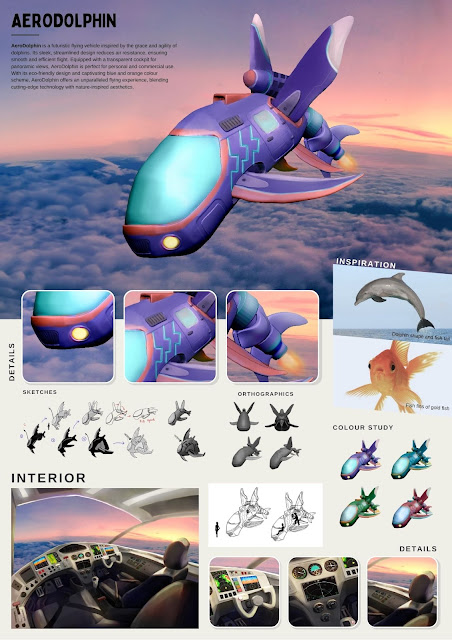Vehicle and Props Design - Final Project : Post Production and Profiling
48/7/2024 - 1/8/2024
Week 12 - Week 15
Ng Jia Ern 0363033
Vehicle
and Props Design
Final Project : Post Production and Profiling
INSTRUCTION
To-do:
Final Polished for each vehicles (Land, Water and Air). Call sheet
showcasing the breakdown's of your props, interior and engine (if
necessary). Key Art For all 3 vehicle concept as example attached. Call
sheet needs to be well laid out.
- Color studies
- Textures
- Key Art
- Props Breakdown
- Orthographic
Output 16:9 1920+ Illustration compiled in pdf format. *please keep your
single rendered images separate as well.
Task:
I refined my vehicle 3D model in ZBrush
Front View:
Paint Over in Photoshop:
Refined paint over:
Added background:
Then, I created a presentation board for my vehicle design, I named this
vehicle AerpDolphin.
Final Project:
Presentation Board:
Compilation of Exercise, Project 1, Project 2, Final Project and Presentation Board:
REFLECTION
Initial Reluctance and the Need for Growth
Dislike for Vehicle Design:
- I must admit that designing vehicles is not something I enjoy. However, I recognize that it’s an essential skill, not just for this course but also for my future career. Therefore, I’m determined to overcome my reluctance and learn how to design vehicles effectively.
Learning Blender vs. ZBrush:
- This module was supposed to focus on learning Blender for modeling, which is particularly suited for hard surface modeling like vehicles. However, due to the hectic nature of this semester, with so many assignments and new skills to learn, I didn’t dedicate enough time to properly learn Blender. Instead, I chose to model my vehicle in ZBrush, even though I believe Blender would have been more efficient for this task. I plan to catch up during the semester break by properly learning Blender, as ZBrush proved to be quite challenging for vehicle design.
Time Constraints and Personal Discipline:
- This semester has been overwhelming due to the heavy workload from five different modules. Balancing classes and assignments left me with very little time to work on my vehicle design. Additionally, I have to admit that my own procrastination and lack of discipline played a role in not making the most of the time I had. I understand that time management and discipline are areas I need to improve on to succeed in such demanding courses.
Struggles with Fundamental Practice
Incomplete Fundamentals:
- At the start of the course, we were expected to complete fundamental exercises, such as drawing the deformation of three different types of vehicles. Unfortunately, I didn’t manage to finish these exercises in time. The primary reason was my lack of a strong drawing foundation, which made these exercises particularly challenging. Drawing, especially with accurate perspective, has always been difficult for me, but I am eager to improve. I plan to continue practicing these fundamentals even after the course ends, focusing particularly on perspective drawing, which I find the hardest to grasp, especially with curved surfaces.
Solution for Perspective Challenges:
- To tackle my difficulties with perspective in vehicle design, I used ZBrush to create simple models of the vehicles. By rotating these models to the desired angle and taking screenshots, I could ensure that my drawings were accurate in terms of perspective. For the vehicle's interior, specifically the driver's seat, I took photos of my own car from the angles I wanted to draw. Using these photos as references helped me avoid making perspective errors.
Design Challenges and Problem-Solving
- Design Logic and Functionality:
- One of the major challenges I encountered in vehicle design was ensuring that my designs were logical and functional. It was difficult to know if the design I had in mind would actually work in real life. The most challenging aspect was understanding how the vehicle would operate—how it would start, function, and how its different parts would interact. To address this, I spent a lot of time researching references on Pinterest and YouTube. For instance, when designing a spaceship, I studied how airplanes operate, the structure of helicopters, the appearance of cockpits, and how landing gear retracts. This research helped me make more informed decisions about my vehicle designs, ensuring they were both logical and feasible.
Overall Experience and Future Plans
Gained Understanding of Vehicle Structures:
- Despite the challenges, this module has provided me with a much better understanding of vehicle design and structure. I now have a clearer idea of how different vehicles are constructed and how to approach designing them in the future. Although I still have much to learn, I feel more confident in my ability to take on vehicle design projects going forward.
Commitment to Continued Practice:
- I am committed to continuing my practice in vehicle design. I recognize that consistent practice is key to improving my skills, and I plan to dedicate time to this even outside of my coursework. By mastering vehicle design, I’ll not only be better prepared for future projects but also expand my versatility as a designer.
Using Breaks for Skill Development:
- During the semester break, I plan to catch up on the skills I didn’t manage to fully learn during the course, particularly Blender. Learning Blender will be crucial for improving my efficiency in vehicle design, especially since it’s better suited for hard surface modeling compared to ZBrush. I’m determined to use this time effectively to strengthen my foundation in both software and design principles.








Comments
Post a Comment